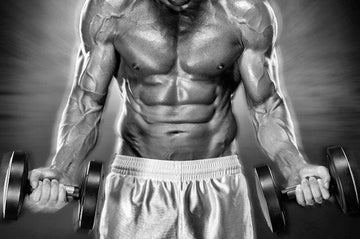

Do Bodybuilders Still Need to Train Heavy While Dieting for a Contest?
Table of Contents
Do Bodybuilders Still Need to Train Heavy While Dieting for a Contest?
By: Robbie Durand
If you have ever seen the “sucked in” faces of competitors and the shredded abs on stage, you can see they have no bodyfat and their jawline is distinctly visible with noticeable vascularity in their arms and legs. Most bodybuilder’s have no problem getting bigger but it’s the intense dieting that separates the top ranked bodybuilders from those that place lower. One of the most controversial subject’s that bodybuilders and trainer’s have is when your cutting for a bodybuilding show and your following a low calorie diet and increased cardio, should you still train heavy? Most trainers will advocate that one must keep training heavy but the research seems to advocate that training to failure with a lighter weight can be just as effective as training heavy.
Training Intensity and Protein Synthesis
For many years, researchers thought that heavy weight was the only way to increase muscle protein synthesis. New research has found that in addition to training with heavy weights, exercise-induced metabolic stress may promote gains in muscle mass, as evidenced by some of the new research with tourniquet training. Tourniquet training uses blood flow occlusion, which cuts off blood circulation, uses very low weight but can produce muscle growth similar to using heavy weights. Acute muscle hypoxia (i.e. low oxygen) associated with resistance training may serve to further augment metabolic stress placed on the muscle and stimulate muscle growth. Oxygen delivery to the muscle appears to be compromised to a greater degree during a tourniquet training protocol as a result of arterial compression. Tourniquet training produces large increases in lactate has shown to augment anabolic signaling proteins and intramuscular signaling proteins. In a recent study, researchers reported a greater intramuscular anabolic signaling pathway mTORC1 activation following a bodybuilding style, hypertrophy protocol (80% 1-RM, 5 sets × 10 repetitions, 2-min rest interval) compared to a very low-volume strength protocol (100% 1-RM, 15 sets × 1 repetition, 3-min rest interval) using the bilateral leg press). This study suggests greater anabolic signaling with a lighter weight with higher repetitions protocol compared to a heavy weight protocol. Another study investigating the anabolic intramuscular pathway mTORC1 signaling in conjunction with circulating concentrations of hormones, markers of muscle damage, and lactate following a typical lower-body hypertrophy protocol (70% 1-RM; 4-6 × 10-12 repetitions; 1-min rest intervals) and strength training resistance exercise protocol (90% 1-RM; 4-6 × 3-6 repetitions; 3-min rest intervals) in trained men. As anticipated, the hypertrophy protocol stimulated a greater hormone and lactate response, while the strength workout elevated markers of muscle damage to a greater degree. However, the regulation of anabolic signaling proteins within mTORC1, including Akt, mTOR, p70S6k, and RPS6, were not significantly different following each protocol. Despite significant differences in the endocrine response and by product accumulation, both protocols appeared to elicit similar intramuscular anabolic signaling in resistance-trained men. It is plausible that the relationship between intensity load and muscle protein synthesis may reach a plateau between intensities of ~60-90% of 1-RM. This means that the amount of weight that is on the bar is not necessarily going to result in greater increases in muscle mass.
Training to Failure and Protein Synthesis
Researchers reported that taking sets to failure seemed to enhance the anabolic effects of whey protein regardless of how much weight was lifted. The researchers had subjects consume a whey protein drink (15 grams of whey protein) at rest and before exercise and then had the subjects perform leg exercises where immediately after they had muscle biopsies taken to measure markers of protein synthesis. The subjects performed either:
-4 sets at 90% of maximal strength to failure (90FAIL);
-30% work-matched not to failure; or
-30% to failure (30FAIL).
So in sum, the researchers had the subjects lift heavier weights to failure (90% of a 1-RM) and lighter weights to failure (30% of a 1-RM), and light weights not until failure (30% of a 1-RM). At the end of the study, protein synthesis was increased after exercise for 24 hours after exercise was performed. Additionally, the researchers reported that regardless of intensity or weight used, the researchers found that muscle protein synthesis was observed only after exercise performed until failure (i.e. 90FAIL and 30FAIL), which may suggest that maximal fiber activation (especially of type II fibers) is necessary for activation of muscle protein synthesis after exercise. When exercise in the lightweight group was not taken to failure, protein synthesis did not occur.
The researchers speculated that protocols eliciting maximal fiber recruitment (i.e. both type I and type II fibers using manipulations of load and volume to induce fatigue) during exercise are critical to enhancing the anabolic effects of exercise for at least 24 h postexercise recovery. One may question how can a weightlifting programs using such a lightweight be effective for enhancing muscle protein synthesis? You have to consider although one protocol (i.e. 90% of a 1-RM) lifted heavier, the lighter program (30% of a 1-RM) lifted longer. What this means is that bodybuilding may want to vary their workouts using both heavy and light protocols in conjunction with using a high quality whey protein such a to enhance muscle protein synthesis. This suggests that bodybuilders can get similar increases in protein synthesis with the performance of low-load and high volume until fatigue.
EMG activity and Training Intensity
Researchers wanted to measure the electrical activity of muscle fibers in response to two different weight lifting protocols. EMG (i.e. muscle activation) analysis of the vastus lateralis (i.e. legs) during a lower-body hypertrophy protocol (70% 1-RM; 4-6 × 10-12 repetitions; 1-min rest intervals) and strength training resistance exercise protocol (90% 1-RM; 4-6 × 3-6 repetitions; 3-min rest intervals) revealed no statistical difference in mean muscle activation in trained men during the barbell back squat and leg press exercises. This means that lifting about 70% of a 1-RM is not going to result in greater muscle activation, its possible that there is a muscle threshold. Another study comparing a lower-body hypertrophy protocol and strength training protocols, similar EMG muscle activation patterns have been reported in trained men. EMG analysis of the vastus lateralis during a lower-body hypertrophy protocol (70% 1-RM; 4-6 × 10-12 repetitions; 1-min rest intervals) and strength training resistance exercise protocol (90% 1-RM; 4-6 × 3-6 repetitions; 3-min rest intervals) revealed no statistical difference in mean muscle activation in trained men during the barbell back squat and leg press exercises.
Key Points: The current research suggests that muscle protein synthesis seems to be increased from 60-90% of a 1-RM, this means that when dieting for a competition, training a little lighter can maintain muscle protein synthesis. Training above 90% of a 1-RM does not seem to add any extra benefits in terms of protein synthesis or anabolic signaling pathways. Don’t risk injury during prep and stick to the lighter training protocols to failure.
Nicholson G, Mcloughlin G, Bissas A, and Ispoglou T. Do the acute biochemical and neuromuscular responses justify the classification of strength-and hypertrophy-type resistance exercise? The Journal of Strength & Conditioning Research 28: 3188-3199, 2014.
Burd NA, West DW, Staples AW, Atherton PJ, Baker JM, Moore DR, Holwerda AM, Parise G, Rennie MJ, et al. Low-load high volume resistance exercise stimulates muscle protein synthesis more than highload low volume resistance exercise in young men. PLoS ONE. 2010;5: e12033.
Burd NA, Holwerda AM, Selby KC, West DW, Staples AW, Cain NE, Cashaback JG, Potvin JR, Baker SK, et al. Resistance exercise volume affects myofibrillar protein synthesis and anabolic signalling molecule phosphorylation in young men. J Physiol. 2010;588:3119–30.
Burd NA, West DW, Moore DR, Atherton PJ, Staples AW, Prior T, Tang JE, Rennie MJ, Baker SK, Phillips SM. Enhanced Amino Acid Sensitivity of Myofibrillar Protein Synthesis Persists for up to 24 h after Resistance Exercise in Young Men. J Nutr. 2011 Apr;141(4):568-73.
Hulmi J, Walker S, Ahtiainen J, Nyman K, Kraemer W, and Häkkinen K. Molecular signaling in muscle is affected by the specificity of resistance exercise protocol. Scandinavian Journal of Medicine & Science in Sports 22: 240-248, 2012.
Oishi Y, Tsukamoto H, Yokokawa T, Hirotsu K, Shimazu M, Uchida K, Tomi H, Higashida K, Iwanaka N, and Hashimoto T. Mixed lactate and caffeine compound increases satellite cell activity and anabolic signals for muscle hypertrophy. Journal of Applied Physiology 118: 742-749, 2015.
Popov DV, Lysenko EA, Bachinin AV, Miller TF, Kurochkina NS, Kravchenko IV, Furalyov VA, and Vinogradova O. Influence of resistance exercise intensity and metabolic stress on anabolic signaling and expression of myogenic genes in skeletal muscle. Muscle & Nerve 51: 434-442, 2015.
Schoenfeld BJ. Potential mechanisms for a role of metabolic stress in hypertrophic adaptations to resistance training. Sports Medicine 43: 179-194, 2013.
Kumar V, Selby A, Rankin D, Patel R, Atherton P, Hildebrandt W, Williams J, Smith K, Seynnes O, and Hiscock N. Age-related differences in the dose–response relationship of muscle protein synthesis to resistance exercise in young and old men. The Journal of Physiology 587: 211-217, 2009.
Gonzalez AM, Hoffman JR, Townsend JR, Jajtner AR, Boone CH, Beyer KS, Baker KM, Wells AJ, Mangine GT, and Robinson EH. Intramuscular anabolic signaling and endocrine response following high volume and high intensity resistance exercise protocols in trained men. Physiological Reports 3: e12466, 2015.

















